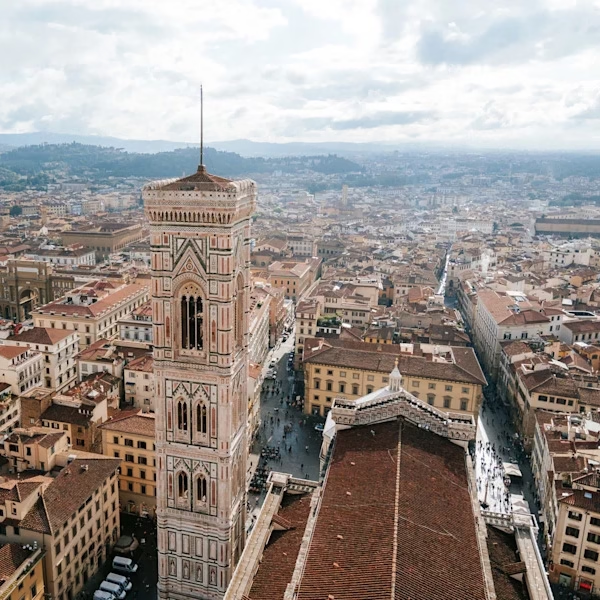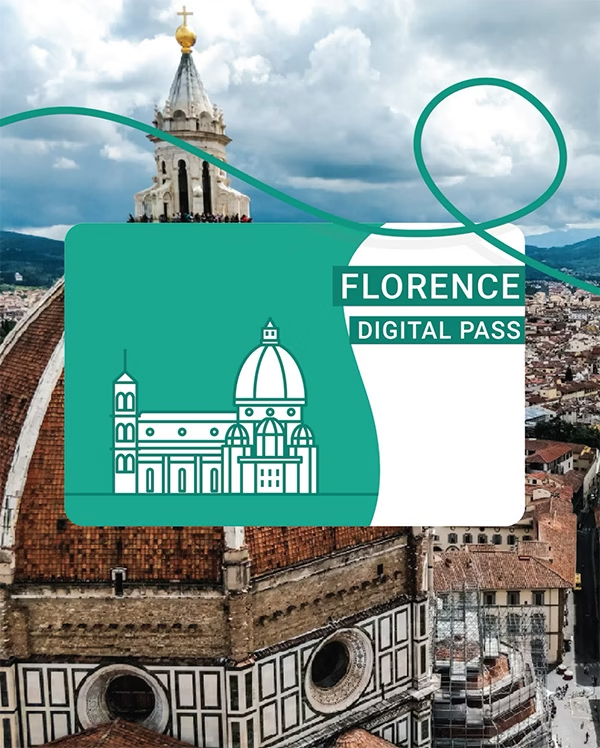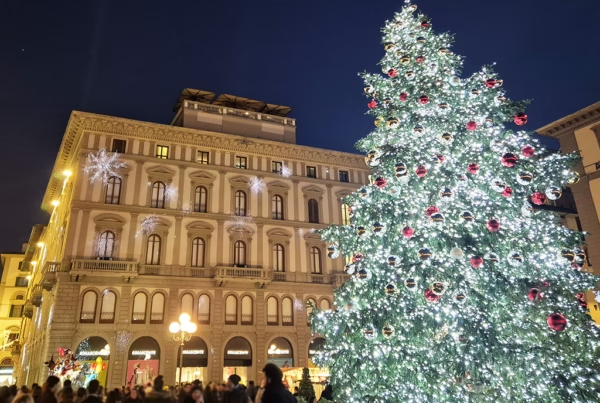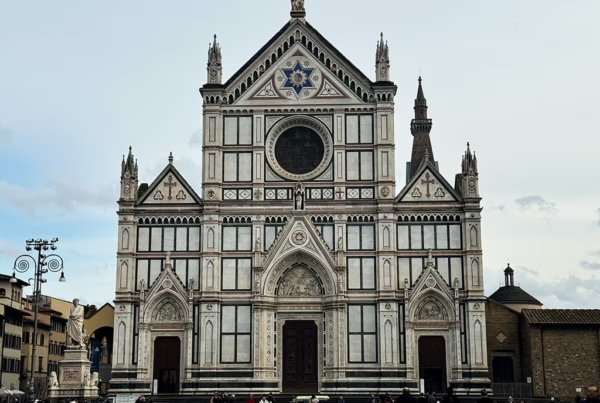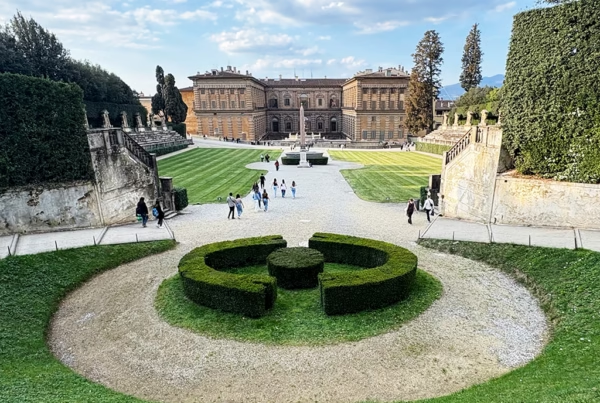The Basilica of Santa Maria Novella Florence is one of the most important churches in the city, located right next to the central train station of the same name.

This is the view that greets you when you step out of Florence’s main train station – not bad
Whether you’re visiting Florence for a day or much longer, I highly recommend you not miss out on visiting the Santa Maria Novella church. It’s one of the most beautiful places you will see in the city.
Everything you Need to Know About Visiting the Basilica of Santa Maria Novella Florence
The location of the church right across from Florence’s main train station means that visitors sometimes miss out on seeing everything the church of Santa Maria Novella has to offer, but this would be a mistake.

These stunning ceiling frescoes are only one of the many reasons to visit the Santa Maria Novella church
Read on for the fascinating story of Santa Maria Novella, and find out why a visit here can only enhance your experience in Florence, including:
A Brief History of the Basilica di Santa Maria Novella complex
There has been a church on the site of Santa Maria Novella for nearly a thousand years, with the original church called Santa Maria delle Vigne.
In the early thirteenth century the building and surrounding land were granted to an order of Dominican friars, who decided to build a convent complex, complete with a new church, cloister and a chapter house. The name ‘Santa Maria Novella‘ comes from the fact it was a new (novella) church dedicated to Mary.
The order of Dominican friars who built the Basilica of Santa Maria Novella also founded the oldest pharmacy in the world, let alone Italy.
The Officina Profumo Farmaceutica di Santa Maria Novella still sells fragrances and other products based on the monks’ medieval recipes.
The original project designs created by the Dominican friars were already stunning, but over time further work was completed on the structure, creating an exquisite example of Gothic architecture.
As the first basilica built in Florence, Santa Maria Novella has been a silent witness to the genius of Italy and Italian artists. The church was enriched over time with works of art from the Medieval era through to the Renaissance and Baroque, with each piece collected perfectly symbolic of its era.
The Architecture of the Santa Maria Novella Church
Santa Maria Novella Façade
The white marble facade of Santa Maria Novella in Florence is one of the most important architectural works of the Florentine Renaissance. The Romanesque, lower part of the marble facade is the original design, but the upper part was designed by Leon Battista Alberti and added in the 1400’s.

From this angle you can see the difference between the plain side walls and intricate facade
Further architectural interventions took place over the centuries, and was only definitively completed in 1920.
The interior structure
Entering through the main entrance into the atrium, your gaze inevitably goes up to the ceiling. You’ll see a distinctive T-cross shape, divided into three naves with six wide bays that get smaller as they get closer to the altar wall. This architectural technique makes the building seem longer than it actually is.
Also, the width and height of the central nave are designed to make it look like the arches easily merge into one grand hall.

The view of the inside of the beautiful Santa Maria Novella is spectacular
Organize your transport easily and stress-free for any trip to Florence and Tuscany:
Presbytery
This is the name of the area reserved for the members of the clergy, with the choir and altar.
The presbytery in Santa Maria Novella was originally separated from the general seating area by large decorated walls meant to divide the clergy from the congregation. Cosimo I de Medici, Grand Duke of Tuscany, later decided to take the wall down and remodel the interior.
He appointed the popular Renaissance master Giorgio Vasari to carry out the remodel. Vasari had the wall demolished and added a number of chapels.
He also restyled the choir.
As an accomplished painter, architect and writer, Vasari left his mark all over Florence.
He designed the Vasari Corridor that connects the Uffizi Gallery to the Pitti Palace, as well as renovating the Basilica of Santa Croce and creating numerous pieces of art, such as the walls and ceiling in the Sala di Cosimo I in Palazzo Vecchio.
Floor & Windows
As you walk through the church, you’ll see the remains of tombstones on the floor dating back hundreds of years. There was once a lot more but during a major restoration in the middle of the 19th century, some of the tombstones were relocated to between the side pillars.
During these restorations the main altar (an excellent neo-Gothic piece) was also rebuilt, along with the windows, along with stained glass window, giving the church its current look.
An exclusive experience at the Duomo awaits ✨
Join this exclusive tour and explore one of Italy’s most iconic churches, Florence’s Duomo. Enter after closing time for a VIP, crowd-free experience, including climbing up inside the famous dome and going outside onto the cathedral terraces! Click here to secure your spot today!
Special Things to see Inside The Santa Maria Novella Church Florence
The inside of the Basilica of Santa Maria Novella is filled with some true masterpieces. Here are the must-see things to look out for:
Giotto’s Crucifix
The extraordinary crucifix is wood painted with tempera and gold, originally created at the end of the 13th century. The artist of this masterpiece is the genius Italian painter Giotto Bondone, who also designed the Campanile bell tower next to the Florence Duomo.

Giotto’s crucifix hanging above the people below is definitely impressive
It’s located all the way at the end of the main nave, supported by a metallic structure to keep it up high, and anchored to a winch which allows it to be lowered to the ground when needed.
Masaccio’s Trinity
Located in the middle of the left aisle you will find the fresco of the Trinity by Tommaso Guidi, also known as Masaccio . Beyond the refined technique and its perfect Renaissance prospective, this piece of art tells a long story.
When the Santa Maria Novella church was originally built, it was decorated throughout with frescoes. As part of Vasari’s renovations, it was ordered that these frescoes were to be largely removed or covered up.
Vasari, who understood this fresco’s immense historical and artistic value, decided to relocate it behind a new altar instead, leaving a small gap between the wall and the painting, meaning Masaccio’s work would not suffer further damage.
It was not until 1860 that the fresco was rediscovered, when it was restored and transferred onto a canvas before being displayed on the counter-façade of the church.
The most curious incident took place during a restoration in 1952, when the Cultural Heritage Department of the time decided to relocate the fresco to its original location.
To do so, the altar that Vasari had built was removed.
This brought to light a painting of a sarcophagus and a skeleton of which, until that point, there was no record at all.

The rediscovered fresco, now on display in a different part of the church
Resurrection of Lazarus
If you walk towards the left nave you’ll see another marvellous example of Florentine painting from the 16th century, the Resurrection of Lazarus by Santi di Tito.
This oil on canvas is one of many paintings commissioned by Vasari during his renovations, in line with the use of sacred images during the counter-Reformation period. Truly extraordinary!
The Strozzi Chapel
Possibly the most famous chapel in Santa Maria Novella in Florence, the Cappella Strozzi is in between the Bardi Chapel and the Tornabuoni Chapel. Its fame is due to the incredible frescoes by Filippino Lippi throughout the chapel, which was the last painted series he created.
The Crucifix by Filippo Brunelleschi
The first chapel you will see on your left as soon as you enter the church is known as the Gondi Chapel, named for the family who designed it. However the reason this chapel became so famous is the wooden crucifix by Brunelleschi.

This crucifix is unbelievably detailed, and carved entirely from wood
Filippo Brunelleschi was a Florentine sculptor and architect, most famous for completing the dome of Florence’s cathedral, but also completed a number of sculptures. This crucifix is the only wooden work he ever created, so it is incredibly special to see his depiction of Christ on the cross up close.
Tornabuoni Chapel
Also known as the Major Chapel, this chapel is the home of the famous fresco cycle by Domenico Ghirlandaio. The Ghirlandaio frescoes portray the lives of the Virgin Mary and St John the Baptist (Florence’s patron saint) in a series of scenes.
They also have images of the Dominican saints St Dominic and St Peter Martyr, along with the evangelist saints.

The colors and details in this chapel fresco are so vibrant, you can’t help but stare
Given the complexity of this epic work, Ghirlandaio assembled a team of young, but already famous collaborators including two of his brothers, and even for a short time, Michelangelo Buonarroti himself.
The Spanish Chapel
The Cappellone degli Spagnoli used to be the convent chapter house, but was nicknamed the Spanish Chapel ever since Cosimo I gave it to his Spanish wife and her entourage to use.
The chapel was decorated in the 14th century with frescoes by Andrea di Bonaiuto depicting the life of Christ and also St Peter, along with an incredible piece known as the Triumph of St Thomas Aquinas.

It’s not just the walls in the Spanish Chapel that you should be admiring. Make sure to look up at the ceiling as well.
The Spanish Chapel is now part of the museum of Santa Maria Novella.
The Green Cloister
Also part of the museum, the Green Cloister or Chiostro Verde is the first of the cloisters in the Santa Maria Novella complex. The name comes from the Old Testament frescoes painted in this cloister by Paolo Uccello in the 15th century with a green clay that was popular at the time.
From the Green Cloister you can access the Strozzi Chapel, the Spanish Chapel and the refectory, where important items from the church’s history are on display.
Discover Florence easily with this pass!
Access the Uffizi Gallery, Accademia Gallery, and Brunelleschi’s Dome, all with one ticket by getting yourself this unique Florence digital visit card. Save money and make visiting the top sites stress-free – click here to find out more:
Opening Hours and Mass Times for the Church of Santa Maria Novella
There are two parts to the complex of Santa Maria Novella, the basilica itself and the museum. The church is always open for personal prayer and for religious functions, but if you enter for these reasons you will not be able to explore the entire complex.
Similarly, access for visitors is restricted on religious holidays and when masses are taking place.

The cloister is part of the museum, so access is only possible during the museum opening hours
The Santa Maria Novella perfumery is close to the basilica but access is completely separate. As a regular store you can browse and sample the products during their regular opening hours, but there is often a queue as the staff do not let the store get too busy.
Check out the official site of the Officina Profumo-Farmaceutica Santa Maria Novella for more details of their product range and specific store hours.

The pharmacy sells all sorts of products based on centuries of experience
Opening hours
Access to the full Santa Maria Novella complex varies slightly according to the day of the week and time of year so make sure you have the right information for when you are visiting.
Last admission is always one hour before closing time, and the complex is completely closed to visitors on Good Friday and Holy Saturday. Check the official website for current opening hours and days.
Regular masses are held in the church which you can attend if you wish, but you cannot access the museum parts without a valid entrance ticket.
Tickets
You can purchase tickets online or at the ticket office on site, but I would recommend booking in advance to avoid disappointment. You can also choose to book a private tour of Santa Maria Novella Florence to explore its sights in detail, or see the outside on a group walking tour.
Where is Santa Maria Novella Florence and How to Get There
Santa Maria Novella is the only church opposite the central train and bus station with the same name so is very easy to reach. You can walk to the Piazza Santa Maria Novella from most places in the historic city center within 20 minutes, or you can take one of the buses that stop across the street.
Be sure to Pin this guide if you enjoyed it or found it useful!
Save this page by pinning it and be sure to follow us on Pinterest for more travel inspiration and guides:

To sum up…
The Basilica of Santa Maria Novella Florence is often overlooked as people rush to get to other more well-known sites in the city, but this would be a mistake. The inside of the church is filled with artistic masterpieces tracing through the centuries of Florentine history, perfect for a few hours of exploration!
For lots more Florence travel tips, tricks and recommendations, be sure to subscribe to our 100% free Florencewise newsletter. Subscribers also get exclusive discounts and perks from our friends and partners helping saving you money on your trip here!
Florencewise’s Top Travel Resources
Ready to book your trip to Florence? Take a look at these helpful links to friends and partners we use ourselves and trust:
🚕 Organise your airport transfer for a stress-free arrival
🛏️ Search for and book your perfect accommodation
🧳 Our complete guide to what to pack for Florence
⭐️ The number one travel accessory, a multi-point travel adapter and voltage converter
🏛️ Browse a huge range of tours in Florence, Tuscany and beyond
👌 Experience unique tours and special access to Florence’s most popular sights
💪 Protect yourself with comprehensive travel insurance
📱 Stay connected without incurring large fees with a reliable eSim
🚂 Plan your train journeys and purchase tickets all in one place


